As drought conditions tease the Midwest, minds turn to water-wise plants that can take the heat with little stress. These are generally established perennial plants and shrubs that have adapted to low-moisture conditions, so they need less water. Many are also pollinator friendly. During National Pollinator Week – and throughout the growing season – we celebrate plants that also provide food and habitat to butterflies, bees and birds.
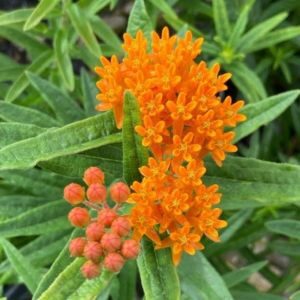
Butterfly Milkweed (Asclepias tuberosa)
Butterfly Milkweed (Asclepias tuberosa)
Durability, beauty and function: The butterfly milkweed is very drought tolerant and actually prefers dry soils with low moisture. It’s also a pollinator magnet, attracting butterflies, birds, bees and hummingbirds from June through early fall. Oval-shaped leaves provide essential food for monarch caterpillars. Monarch butterflies thrive off the plant’s nectar.
Asclepias tuberosa naturalizes if allowed to go to seed, making it an excellent choice for wildflower landscapes. In the residential landscape garden, control the plant population by removing seed pods before they split open. Butterfly milkweed is deer resistant and requires very little care. Mature height is 3 feet; width is 2 feet. Plant in full sun, in USDA Hardiness Zones 4 to 9.
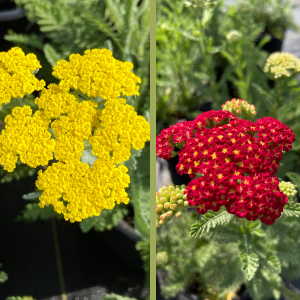
Moonshine Yarrow (Achillea x ‘Moonshine’), left, and Strawberry Seduction Yarrow (Achillea millefolium ‘ Strawberry Seduction’)
Yarrow
If you’re looking for color, variety and drought tolerance in the Midwest landscape – yarrow’s a great choice. This hardy and versatile perennial comes in a variety of colors. An aromatic herb, it is an excellent cutting flower. Yarrow attracts butterflies and is pest resistant. In a wildflower garden, plant it with butterfly milkweed for an attractive color display.
Showy flower heads are flat but slightly mounded. Tiny, compact flowers bloom in clusters above green, fern-like foliage. Plant yarrow where you won’t mind giving it some room, as it is a vigorous grower. At maturity, this perennial is 2 feet tall and wide. For healthy growth, divide yarrow every few years. Otherwise, yarrow is very low maintenance. Plant in full sun, in USDA Hardiness Zones 3 to 9.
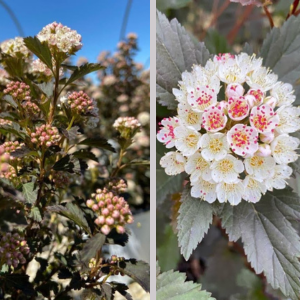
Tiny Wine® Ninebark (Physocarpus opulifolius), left, and Summer Wine® Ninebark (Physocarpus opulifolius)
Ninebark
You know it’s summer in the Midwest when the ninebark blooms. And talk about drought tolerance! This shrub doesn’t mind dry spells. With a mounded habit and arching branches, ninebark explodes in summer. Five-petaled, button-size flowers are pink-white and cover the shrub like a blanket. Oval leaves are about 4 inches long and lobed. Ninebark produces attractive fruit pods and yellow fall color. Enjoy its exfoliating bark in winter. This shrub is loved by bees and other pollinators and is a favorite nesting shrub for birds.
Ninebark requires almost no maintenance. It is drought tolerant and adapts to most soils. With varied sizes from miniature to large, ninebark is a good choice for small and large landscapes. For example, Tiny Wine® Ninebark is 3 to 5 feet tall and 3 to 4 feet wide at maturity. Summer Wine® Ninebark is 5 to 8 feet tall and wide. Plant ninebark in full sun to part shade. While it flowers best in full sun, it also does quite well in partial shade. Ninebark does well in fertile soil, in USDA Hardiness Zones 3 to 9.
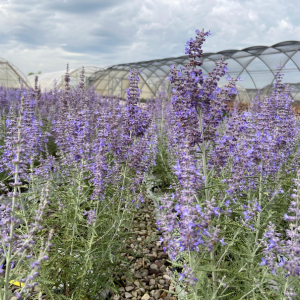
‘Denim ‘n Lace’ Russian Sage (Perovskia atriplicifolia)
‘Denim ‘n Lace’ Russian Sage
Fragrant ‘Denim ‘n Lace’ Russian Sage is perfect for the Midwest’s hot, dry areas. Lacey, purple-blue flowers are held on sturdy stems in an upright habit. Blooms begin in mid-summer and continue through mid-fall. Keep the stems up through winter for added interest.
This hardy perennial tolerates a variety of soils and has multiple uses in the landscape, as well as in dried and cut flower arrangements. Hummingbirds love it. Deer do not. ‘Denim ‘n Lace’ Russian Sage has a mature height of about 3 feet. Width at maturity is also about 3 feet. Plant in sun, in USDA Hardiness Zones 4 to 9.
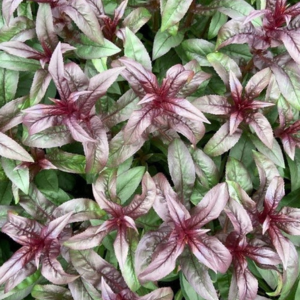
Beardtongue (Penstemon ‘Onyx and Pearls’)
Onyx and Pearls Penstemon
“Just gorgeous,” is the best way to describe this hardy perennial, which grows from rhizomes. It is named for its deep-dark purple foliage and soft lavender trumpet flowers with white centers. Foliage is waxy-green on tall stems to support the plant’s upright habit. Onyx and Pearls Penstemon doesn’t mind the heat and is very cold hardy, too. Drought tolerant once established, it isn’t bothered by soil type or bugged by insects or diseases. This penstemon beckons hummingbirds to its nectar-rich blooms. Long blooming, it also attracts butterflies and other beneficial pollinators.
Onyx and Pearls Penstemon is super easy to grow. It likes loose soil with good drainage. It is hot/dry and salt tolerant, producing its pretty blooms all summer. Divide this perennial every few years in spring by digging up mature rhizomes and planting them elsewhere in the landscape. Refresh the plant by trimming the foliage after it completes its bloom. This penstemon is 3 to 4 feet tall and wide at maturity. Plant it in full sun, in USDA Hardiness Zones 3 to 8.
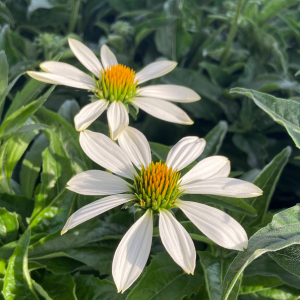
PowWow® White Coneflower (Echinacea purpurea)
White Coneflower
Bright gold centers contrast with snow-white petals and deep green foliage on PowWow® White Coneflower. But don’t be swayed by its beauty – this is one tough coneflower. Once it’s established, the waterwise perennial tolerates mild drought as it attracts butterflies and other beneficial pollinators. It provides continuous blooms from summer through early fall on a compact, mounded habit.
PowWow® White Coneflower likes well-drained, fertile soil and deep, regular waterings in its first growing season. This will help establish its extensive root system. Remove spent blooms to extend flowering. Prune back old foliage in the fall and apply a general fertilizer in spring. This coneflower is about 2 feet tall and 1 foot wide at maturity. It likes full sun. Plant in USDA Hardiness Zones 3 to 9.
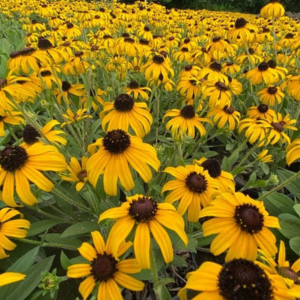
‘American Gold Rush’ Black-Eyed Susan (Rudbeckia hybrid)
‘American Gold Rush’ Black-Eyed Susan
‘American Gold Rush’ Black-Eyed Susan has distinctive black centers and cheery yellow petals. It blooms from mid-summer to early fall and attracts pollinators. This Rudbeckia hybrid is resistant to Septoria leaf spot.
This Rudbeckia is drought tolerant once established and likes well-drained soil. It is about 2 feet tall and 3 to 4 feet wide at maturity. ‘American Gold Rush’ Black-Eyed Susan makes an excellent border plant and is striking when planted in groupings. Add it to cutting and pollinator gardens. It thrives in full sun or part shade. Plant in USDA Hardiness Zones 4 to 9.
Learn About the Loma Vista Nursery Family and Our Landscape Plants
Loma Vista Nursery’s staff members are experts in the field. We love helping people learn and understand more about plants. Visit our plant catalog for information about shrubs, trees and perennial plants that are ideal for Midwest landscapes. To get answers to plant-related questions, send an email to sales@lomavistanursery.com or call (785) 229-7200.
Connect With Us
Stay current on our plant recommendations, growing tips and more by following us on social media.
